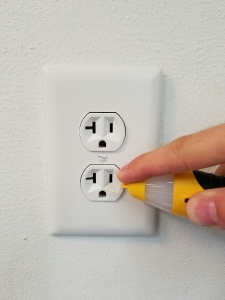As many of you may know non-contact voltage sensors (NCV’s) or “voltage sniffers” are strange and mysterious in how they work or in some cases don’t work. Due to the nature of this product and the science behind non-contact voltage testing, sensitivity is always a variable due to the components used and because your body completes the circuit which will affect your readings. We’re going to clear up some of the confusion behind NCV’s in this article, hopefully this will help bring you a better understanding of how they work. Below you’ll find useful tips and tricks for detecting voltage with a non-contact voltage detector.
One of the first things you want to do before you test for voltage at an outlet is disconnect any device that is connected to that specific outlet. This is largely due to the field that electricity creates. If something is plugged into the outlet, the cord will generally increase the size of the field and make discrete detection difficult at best. The size of the field detected by a non-contact voltage detector can vary significantly in size for a variety of reasons, such as whether the box or cover is metal or plastic. Depending on the fixture (metal or plastic), the field may be greater.
For outlets in a metal box the field would be smaller and greater sensitivity would be required compared to a fixture in a plastic box where less sensitivity is required where the field is larger. GFCI outlets will generally have a larger field, making discrete detection even more difficult. The detection distance for a standard (non-GFCI) outlet, plastic cover, plastic box, should be less than 1 inch. As a result, to determine what is hot in an outlet using a (non-adjustable) voltage detector may require a technique that may not be obvious. We believe the natural way for most people to use a non-contact voltage detector is to approach the outlet directly from the front, as if one were plugging something into the outlet.

When the AC field is relatively large (plastic box/plastic outlet cover), this method will make it difficult to detect what openings of the outlet are hot. What we found works well is to approach each opening from the side. To say it another way, if checking the outlet slot on the left side, approach the outlet from the left. If checking the ground opening, approach the outlet from below. This is assuming the outlet is installed with the ground opening downward; if you approach the outlet from below you should be able to tell if the ground is hot.
If ground opening is toward the top, you can approach from above. We think if you try this, you will find that it is a much more accurate way to determine what parts of the outlet are hot. Remember that your body is part of the functionality of the device and completes the circuit. If you move your finger toward the tip of the non-contact voltage detector (where the antenna is), you will find that this effects (reduces) the sensitivity. Although not an official method of using the device, you may find this tip useful to know in differentiating a hot line, particularly when the field is large or there are several lines in close proximity.

Obviously, do not put your finger near the tip when checking an exposed conductor. It would also be appropriate to wear the proper protective gear for safety.



